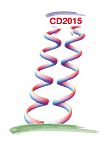Speaker
Lorenzo Contessi
(TIFP, Trento)
Description
In the last years Lattice QCD has substantially improved its predictive power for light nuclei [1,2,3]. Now we have access to data for light nuclei in systems with high pionic mass. We argue that the proper low-energy theory is a contact (or pionless) approach, since for these systems pion effects are of short-range. By means of this effective theory it is possible to extend LQCD predictions to heavier nuclei. The low energy constants of the theory at leading order can be determined using LQCD data of binding energy of deuteron, triton and helion. I will present predictions [4] for binding energy of 4He, 5He, 5Li and 6Li calculated with effective-interaction hyperspherical harmonics (EIHH) and auxiliary field diffusion Montecarlo (AFDMC), then discuss the extension of the method, done with AFDMC, for much heavier nuclei. In this way we illustrate for the first time how to make predictions on nuclei starting from LQCD results, anticipating the procedure that should be adopted with chiral dynamics, once LQCD will be able to give results with smaller pion mass.
References
1. T. Yamazaki, K. Ishikawa, Y. Kuramashi, and A. Ukawa, Phys. Rev. D 86 (2012) 074514.
2. S.R. Beane et al. (NPLQCD Collaboration), Phys. Rev. D 87 (2013) 034506.
3. S.R. Beane et al. (NPLQCD Collaboration), Phys. Rev. C 88 (2013) 024003.
4. N. Barnea, L. Contessi, D. Gazit, F. Pederiva and U. van Kolck, Phys. Rev. Lett. 114 (2015) 5, 052501
Primary author
Lorenzo Contessi
(TIFP, Trento)

